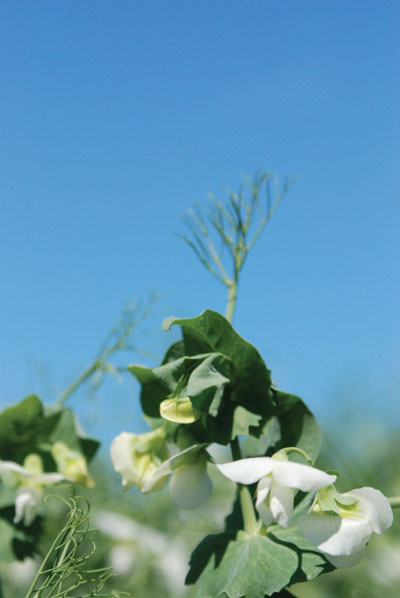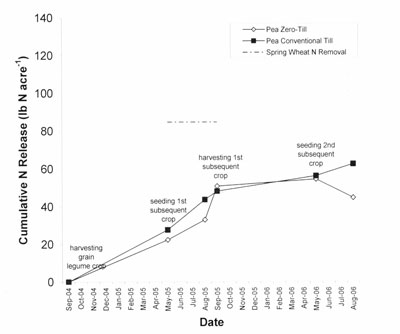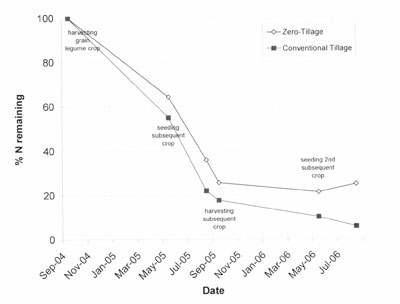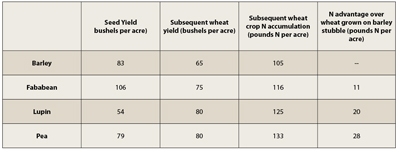
Features
Agronomy
Fertility and Nutrients
Utilizing pulse crops to cut back on N fertilizer
With fertilizer nitrogen (N) prices bouncing all over the place, finding natural nitrogen in a cropping system is a less stressful way for a grower to utilize N than trying to guess where or when to lock in his fertilizer N supply.
March 2, 2009 By Bruce Barker
With fertilizer nitrogen (N) prices bouncing all over the place, finding natural nitrogen in a cropping system is a less stressful way for a grower to utilize N than trying to guess where or when to lock in his fertilizer N supply. With N fertilizer representing approximately 50 percent of the energy costs on a farm, utilizing N fixed by annual and perennial legumes is a renewable source of N for a cropping system, and often comes at a more economical cost.
 |
|
| Pulse crops can contribute between 11 and 28 pounds per acre N to a subsequent wheat crop. Photo courtesy of Bruce Barker. |
Sheri Strydhorst, executive director with Alberta Pulse Growers at Leduc, Alberta, explains that natural N in cropping systems comes from four main sources: perennial legumes like alfalfa, annual grain legumes like peas, legume green manures and legume cover crops. “Increasing the use of N-fixing legume species in crop rotations should increase ecological stability, reduce input costs and reduce the energy footprint of cropping systems,” says Strydhorst, who conducted several years of legume research while pursuing her PhD at the University of Alberta.
First, grow a good pulse crop
Growing pulses like peas, fababeans, lentils and chickpeas is only the first step in getting natural N into the cropping system. Strydhorst explains that a survey of N fixation in farmers’ fields found that levels of N fixation are only a fraction of the theoretical limits that can be achieved under optimal conditions.
In a recent study, Strydhorst found that N fixation is highly dependent on management practices, and that growing a better pulse crop means more fixed N. In the study, fababean, lupin and field pea were planted at various seeding rates, and barley was used to represent weed pressure. On average, weed pressure reduced N fixation yields by 43 percent. Additionally, increasing the seeding rate by up to twice the normal seeding rate increased pulse crop yield by 27 percent and N fixation yield by 35 percent.
Although these benefits carried over to the subsequent crop, the effects were smaller than expected. Strydhorst explains that the non-weedy plots generated seven percent higher wheat yield than the weedy plot, and five percent higher wheat yield on the plots where the pulse seeding rate had been increased. But these differences were only significant in two of six growing environments. These findings suggest that large increases in N fixation, which occur with improved management practices, do not translate into subsequent crop yield increases of equal magnitude.
Gary Hnatowich, a senior research agronomist with Novozymes in Saskatoon, has observed similar yield benefits with higher seeding rates. A survey by Saskatchewan Agriculture and Food of commercial field pea fields indicated that average plant populations were approximately 70 percent of optimal. “Yield loss associated to this lower plant stand could, conservatively, be 15 bushels per acre,” explains Hnatowich. “Producers are encouraged to spend due diligence in all aspects of stand establishment such as seed quality, calibration of rates, seeding dates and optimum inoculation.”

|
|
| Cumulative N release from pea crop residues decomposing under a simulated zero-till system and a simulated conventional tillage system, over a 22-month period.SOURCE: Strydhorst, FarmTech 2008.
|
Proper pulse nutrition is also essential for high yields. Most properly inoculated pulse crops can obtain approximately 70 to 80 percent of their N requirements through N-fixation, with the remaining deficit coming from N in the soil. Research on pea has found that starter N fertilizer is generally not necessary for pulse crops on the Prairies, except, perhaps in the Brown and Dark Brown soils if soil test N levels are less than 20 lbs, in which case an application of 20 lbs N should be considered. This recommendation would likely be also true for lentils.
Hnatowich says that research on dry beans, though, indicates they are the poorest N-fixing pulse crop, and trials in Manitoba and Saskatchewan have indicated that dry beans should be viewed more as an oilseed crop and fertilized with N accordingly.
Capture the rotational N
Much research has documented the beneficial effects of having pulses in rotation, yet contrary to popular belief, much of the increased yield of cereals following a pulse crop is due to non-N factors. Research in Saskatchewan found that only eight percent of the rotational benefit of field pea was related to additional soil N while the other 92 percent was explained by non-N factors such as reduced root and leaf diseases or reduced weed pressure. “What is important with legumes in rotation, is that the next crop has to reclaim the N left over by the pulses,” says Strydhorst.
To help answer how best to reclaim the natural N, Strydhorst looked at the N-supply potential of pulses for a subsequent wheat crop. Theoretically, decomposing grain legume crop residues can supply a significant portion of the subsequent wheat crop’s 85 pounds N per acre needs; pea residues could supply 45 percent; fababean residues 71 percent; lupin residues 125 percent.
 |
|
| Percentage N remaining in crop residues decomposing under a simulated zero-tillage system and a simulated conventional tillage system, over a 22-month period. SOURCE: Strydhorst, FarmTech 2008.
|
However, much of the N released from a decomposing pulse crop is usually not found in the subsequent crop. Rather, other research has found that the leftover N is found primarily in soil organic matter, where the N is gradually mineralized for use by future crops, and where it can increase long term soil fertility.
Another way to keep more of the natural N in the system is to cut back on tillage. A research study found that zero-till systems resulted in slower decomposition and N loss than when the crop residue was buried with cultivation. Strydhorst says that while fababean and lupin residues have the potential to supply more N to subsequent crops than pea residues, the decomposition and subsequent release of N does not necessarily match the subsequent crop’s uptake timing. Her research found that despite lupin and fababeans releasing more N, wheat grown on pea stubble had the highest N accumulation, with lupin providing moderate N accumulation and fababean lower N accumulation.
Generally, the N credit due to the previous pulse crop was between 11 to 28 pounds of N per acre. “Despite pea having lower N supply potential, there may be less N loss than the other pulses, resulting in more N being available to the wheat crop,”
explains Strydhorst. “If fababean or lupin is grown in rotation, producers may have to modify their cropping practices to try to capture more of the natural N. Further work needs to be done to figure out the best way to do this.”Strydhorst says that including a grain legume in the crop rotation once every five years would mean that 20 percent of the acres would require no N fertilizer in the grain year, and reduced N fertilizer in the subsequent crop year(s). But the benefits go beyond just N fertilizer reductions. Measurable improvements in soil structure have been observed, along with increased phosphate, potassium and sulphur availability. Cereal crops grown on legume stubble also tend to have consistently higher protein content. All combined, including a pulse in the crop rotation, can help reduce input costs, increase yields and crop income, and improve the health of the soil.
 |
|
| Subsequent wheat yield, N accumulation, and N advantage as affected by previous crop. SOURCE: Strydhorst, FarmTech 2008. |